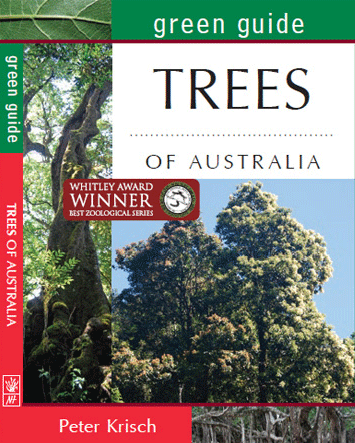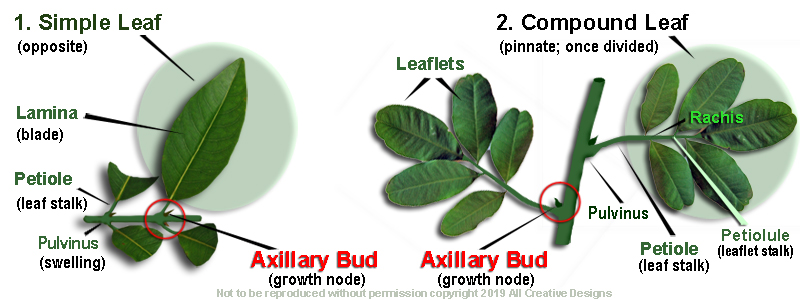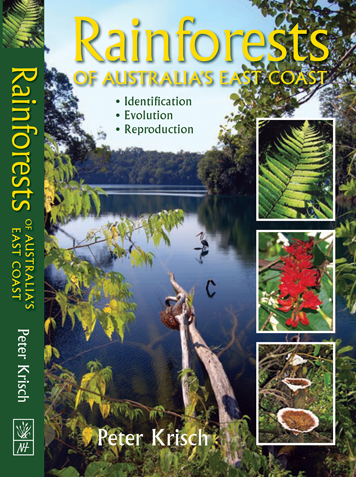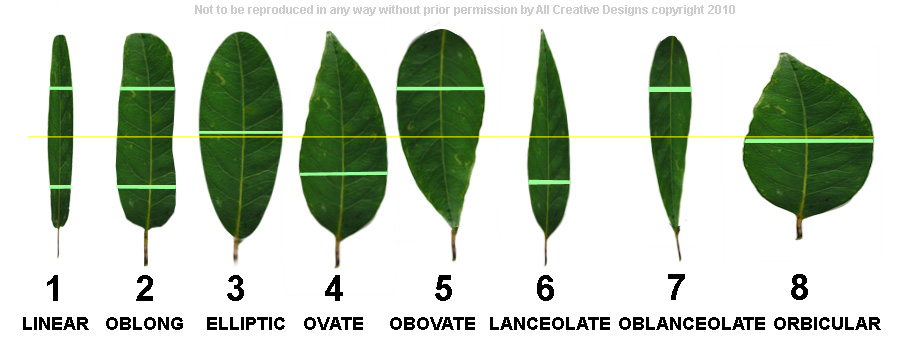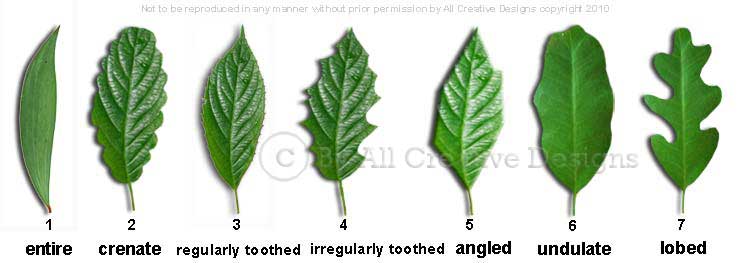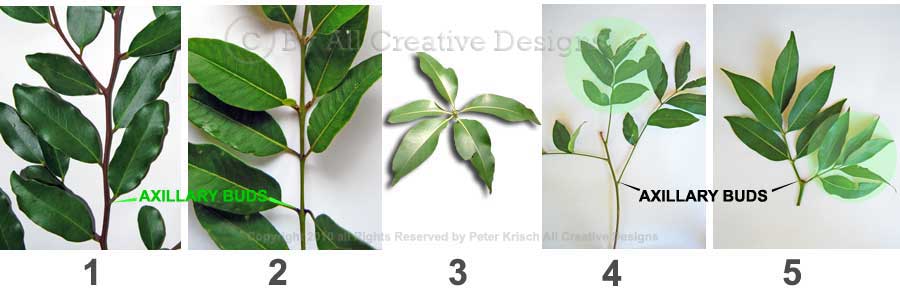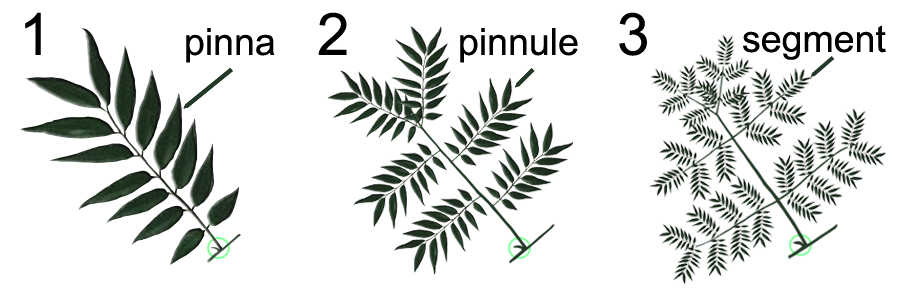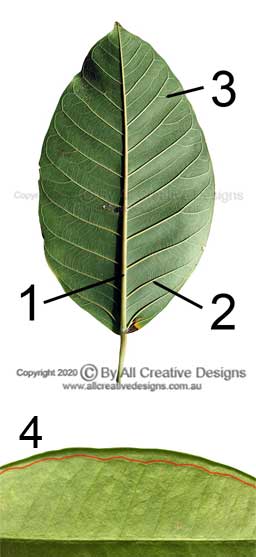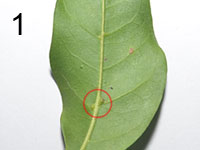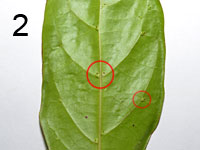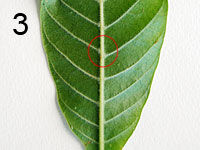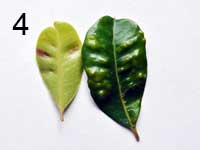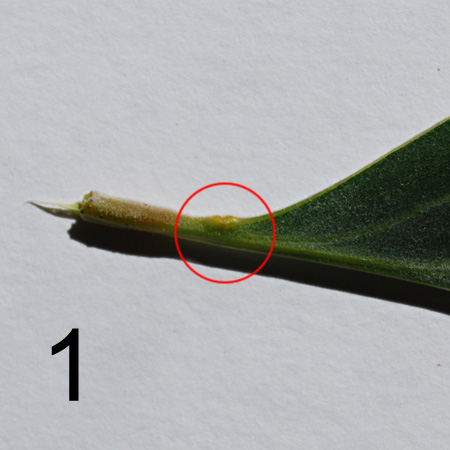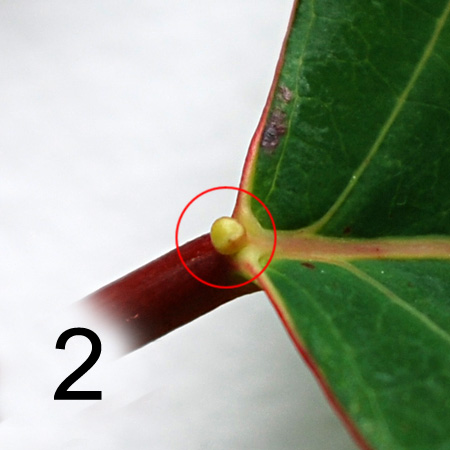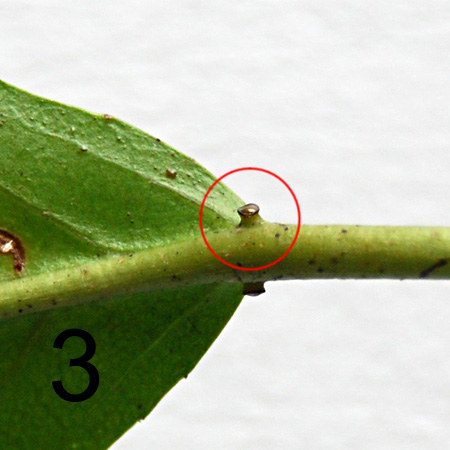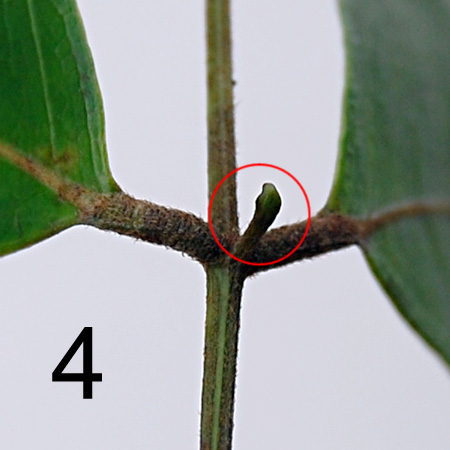
< Expand the Menu to access our Tree Identification pages.
How to identify Australian Native Tree Species by Leaf Characteristics
Introduction: This web page explains leaf characteristics to assist in identification of native Australian tree species. Use the Key to Species, which is based on leaf characteristics, to identify native trees and shrubs found on Australia's east coast. When starting out to identify Australian tree species, the expression "Can't see the trees for the forest" comes to mind. The great diversity of native species makes it a challenge to positively identify native specimens in their natural environment. The often confusing common naming of trees by early settlers refers to similarities in the appearance of the timber grain. This explains why for example the term ‘Oak’ is used for a whole range of different Australian tree families. It is a process of practice and gaining experience in the field to positively identify native trees in their natural habitat. Learning how to use leaf characteristics and other vegetative features, such as the presence of domatia and stipules, is of great help during the process. Using detailed illustrations and a comprehensive language, the methods of recognising native trees and shrubs by vegetative leaf features are explained on the web page below. (Last updated: February 2024).
We hope to raise the awareness to the high conservation value of remaining old growth forests in Australia. 'Trees might be a renewable resource, old growth forests are not'.
Descriptions, images and illustrations copyright ©2024 by www.allcreativedesigns.com.au world wide rights reserved.
Click or Tap Images for Full Size View
green guide to TREES OF AUSTRALIA
How to recognise Australian tree families and genera.
A practical field guide to the identification of native species. More than 200 full colour photographs and detailed descriptions explaining leaf, bark, flower, fruit and other tree characteristics. The guide was written and illustrated by the author of these web pages.
New Holland Publishers: January 2016
Format: Paperback with PVC
Pages: 128 pp.
Size: 13 cm wide x 18 cm high
First Edition, Hand Signed Copies
CLICK HERE FOR MORE INFORMATION Simple versa Compound Leaf Characteristics
Being able to distinguish between a simple and a compound leaf plays an important role in identifying any tree or plant species.
1. A Simple leaf is made up of a leaf stalk called a petiole and a leaf blade (lamina). A small growth node, called an axillary bud, is positioned where the petiole (leaf stalk) joins the stem. This axillary bud can develop into a new shoot or a flowering stem. Depending on the season and tree species these axillary buds can be obvious or inconspicuous and the use of a magnifying glass is recommended. A pulvinus is
the swelling at base of the petiole below the axillary bud.
2. A Compound leaf is formed by two or more individual leaflets. The main difference is the absence of an axillary bud at the base of the
leaflet stalk (petiolule). The graphic above is showing a pinnate compound leaf to the right with 5
leaflets and the only axillary bud appears at the base of the primary leaf stalk (petiole). The rachis is the axis to which leaflets are joined, situated above the petiole (primary leaf stalk). The compound leaf of the Native Tamarind Diploglottis australis can measure more than 1m in length and 60cm
in width, with up to 16 large leaflets arranged along the rachis. Some tree species feature compound leaves that consist of more than 50 leaflets.
See Compound Leaf Characteristics Pinnate & Palmate for more information on this page below.
To familiarise yourself with the concept of a simple and a compound leaf; inspect a sample from a simple leaf tree species known to you, such as the common Creek Sandpaper fig Ficus coronata and compare it to a tree species with compound leaves, such as the Foambark Jagera pseudorhus or Native Tamarind Diploglottis australis. It is recommended to collect material from mature specimens. It is beyond the scope of these web pages to explain the difference of a 1-foliolate leaf, regarded as a reduced compound leaf with only one leaflet, and a simple leaf. Any species with this feature are listed as simple leaves on the tree identification web pages.
Rainforests of Australia's East Coast, HAND SIGNED BOOKS; (Out of Stock) A practical and informative field guide to the identification of native rainforest species. More than 800 colour photographs, informative graphics, maps and detailed description of more than 300 species.
This book is a valuable information source for bushwalkers, students, gardeners and anyone with an interest in Australia’s native flora.
The book was written and illustrated by the author of the tree identification web pages.
New Holland Publishers: May 2019
ISBN: 9781925546293
Format: Paperback with PVC
Pages: 304 pp.
Size: 23 cm high x 15 cm wide
Full Colour Photography
Rainforests: Identification - Evolution - Reproduction
Dedicated photography of rainforest species including; mosses, mushrooms, lichens, slime moulds, ferns, conifers, flowering trees, climbing plants, orchids and palms enable the reader to identify commonly encountered species.
CLICK HERE FOR MORE INFORMATION
Common Leaf / Leaflet Shapes
The illustration above displays only the most common leaf or leaflet shapes, which are mentioned in the descriptions of tree species on our web pages. The green lines, in the graphic image above, are marking the widest points of the leaf/leaflet compared to the centre line. The term ovate (4) translates to egg-shaped, obovate (5); reverse egg-shaped, lanceolate (6); lance-shaped, oblanceolate (7); reverse lance-shaped and orbicular (8) is rounded. Other terms used when describing leaf/leaflet shapes are: falcate (sickle-shaped), rhomboid (diamond-shaped), deltoid (triangular) and cordate (heart-shaped). Many Australian tree species can feature more than one leaf shape on the same tree or even branch and the description may read; leaf/leaflet shape is elliptic or ovate.
It is recommended to collect material from mature trees when identifying tree species by leaf samples.
Common Leaf / Leaflet Margins
Shown above are the leaf/leaflet margin definitions used on the Australian Tree Identification web pages, but the illustration does not show all possible leaf margins (edges). Toothed leaves can feature callus tips or actual spines; can be finely toothed or notched. Other definitions for toothed leaf margins in use are; serrate, serrulate or ciliate. Undulate (Figure 6) are wavy leaf or leaflet margins. Leaf margins can be deeply lobed as in (Figure 7) or show only a couple of shallow lobes. It is quite common to find leaf/leaflets with different margins on the same tree. For example: leaf margins of the Firewheel tree Stenocarpus sinuatus can differ from lobed to entire (Trees Page 5). It is recommended to collect material from mature specimens when identifying tree species by leaf characteristics.
Common Leaf / Leaflet Apices (Leaf Tips) Shapes
Leaf tip (apex; singular / apices; plural) shapes are mentioned in descriptions accompanying Australian tree images. Leaf apices shown in illustration above are the most common shapes and are not a complete selection of possible shapes. Classification applies to both leaf and leaflet apex shape.
1. Rounded or also defined as obtuse. Species often featuring this leaf/leaflet apex are the Doughwood Acronychia octandra and Coogera Ayrtera divaricata.
2. Notched or the botanical definition is emarginate. Guioa Guioa semiglauca and Scented Acronychia Acronychia littoralis are common examples of this leaf or leaflet apex shape.
3. Acute or gradually tapering into a point. A lot of Australian tree species with simple or compound leaves feature this apex shape. The Pink Walnut Endiandra sieberi, Forest Maple Cryptocarya rigida and White Booyong Argyrodendron trifoliolatum are common examples.
4. Acuminate elongated is an apex tapering to a point in a more abrupt way than acute. This shape is commonly found in the genus of Syzygium, such as the Riberry Syzygium luehmannii and the Weeping Lilly Pilly Syzygium floribundum.
5. Acuminate short differs from elongated acuminate in that it tapers into a point over a shorter distance. Examples are; Red-barked Sassafras Cinnamomum virens and Maiden's Blush Sloanea australis.
6. Mucronate is basically a more rounded leaf apex with a short sharp point. Grey Possumwood Quintinia verdonii and the Native Olive Olea paniculata feature this type of leaf apex shape.
Points can either be blunt or sharp. If the point terminates in a spine or a very fine bristle, the apex shape is called aristate.
Common Leaf / Leaflet Base Shapes
The ability to recognise common leaf base shapes is useful in identification of native Australian tree species and descriptions on the tree web pages employ definitions explained below. Classifications apply to both leaf and leaflet base shapes.
1. Attenuate: The term attenuate is used for a leaf base shape tapering (narrowing) very gradually into the petiole over a long distance. Examples for this base shape include the Macleay Laurel Anopterus macleayanus (Page 7) and the Thin-leaved Coondoo Pouteria chartacea (Page 11).
2. Cuneate: The botanical term of cuneate is best described as wedge-shaped, i.e. the base tapers into the petiole over a shorter distance compared to attenuate. This shape is very common, with numerous Australian tree species sharing this feature.
3. Obtuse: An obtuse leaf base shape is rounded and approaches the semi-circular. The Brush Ironbark Bridelia exaltata (Page 2), the Creek Sandpaper Fig Ficus coronata (Page 5) and the Red Kamala Mallotus philippensis (Page 7) are examples for this characteristic.
4. Oblique: An asymmetric or uneven leaf base shape. For example; being rounded on one side and cuneate (wedge-shaped) on the other. This more uncommon leaf base shape is a good identification characteristic. Leaflets of the Hairy Rosewood Dysoxylum rufum (Page 7) and the Red Cedar Toona australis (Page 9) share this feature.
5. Cordate: Heart-shaped, referring to the indented base of the leaf that re-curves to below the joint of the petiole with the leaf blade. Tree species with this leaf characteristic are the Lace Bark tree Brachychiton discolor, amongst other species belonging to the genus. Other more extenuated forms of this shape are called auriculate (forming roundish lobes), sagitate (pointed) and truncate (very shallow indentations not reaching below joint of the petiole).
Leaf Arrangements
1. Alternate arrangement of simple leaves. Sample shown in image 1 is the Black Plum Diospyros australis
2. Opposite arrangement of simple leaves. Sample shown in image 2 is the Native Guava Rhodomyrtus psidioides.
3. Whorl arrangement of simple leaves. Sample shown in image 3 is the Brush Box Lophostemon confertus.
Leaflets (compound) with a whorl like arrangement are called palmate, see Compound Leaf Characteristics Palmate below.
4. Alternate arrangement of pinnate compound leaves. Sample in illustration 4 is the Rosewood Dysoxylum fraserianum
5. Opposite arrangement of pinnate compound leaves. The Five-leaved Bonewood Bosistoa floydii is the example shown in image 5.
View the Common Name Species List to locate above mentioned tree species.
Note: Tree species can feature true whorls where leaves continue this arrangement along older branches or pseudo whorls where leaves change to an alternate or opposite arrangement when maturing. Alternate or opposite arrangements of compound leaves of many Australian tree species is not always consistent. We refer to these different leaf arrangements in our descriptions of native Australian trees accompanying our species identification images.
Compound Leaf Characteristics Pinnate
Green circles show position of axillary (growth) buds.
1. Pinnate Compound Leaf (a once divided leaf blade). The leaflet of a pinnate compound leaf is called a pinna (pl. pinnae). The Hairy Rosewood Dysoxyllum rufum and Native Tamarind Diploglottis australis are species with pinnate compound leaves.
2. Bipinnate Compound Leaf (a twice divided leaf blade). The leaflet of a bipinnate compound leaf is referred to as a pinnnule (pl. pinnules). An example for a bipinnate tree species is the Celerywood Polyscias elegans.
3. Tripinnate Compound Leaf (a 3-times divided leaf blade). The leaflet of a tripinnate compound leaf is called a segment. The Bandicoot Berry Leea novoguineensis features a compound leaf with tripinnate features. (Trees or shrubs with tripinnate leaf features are not common.)
The concept of pinnate, bipinnate and tripinnate doesn’t refer to the number of leaflets or to their arrangement (opposite or alternate). It relates to the axis to which leaflets are attached to. I.e. for a pinnate compound leaf, leaflets (= pinnae) are attached to a primary axis (rachis), for bipinnate; pinnules are attached to a secondary axis and for tripinnate (segments) to a tertiary axis.
Compound leaf characteristics shown in the illustration above are not a complete selection of possible features. The pinnate classification is separated into imparipinnate which features a single terminal leaflet and paripinnate without a single last leaflet. Illustration 1 shows a paripinnate compound leaf. Some tree species, such as the White Cedar Melia azedarach, can bear more than fifty leaflets. The resource link on our 'Australian Tree Identification' pages shows publications and websites with further information.
Compound Leaf Characteristics Palmate
Green circles show position of axillary buds.
4. Bifoliolate Compound Leaf: The bifoliolate (two leaflets) compound leaf of the Twin-leaved Coogera Arytera distylis is an example.
5. Trifoliolate Compound Leaf: The native Doughwood tree Acronychia octandra is a species with this trifoliolate (three leaflets) palmate feature, where each leaflet stalk is attached to a single point. Trifoliolate compound leaves can also be pinnately arranged, i.e. the centre leaflet is attached to a rachis. The term of trifoliate refers to plants with three leaves.
6. Palmate Compound Leaf: Illustration 6 shows the Black Booyong Argyrodendron actinophyllum with up to 9 separate leaflets. Palmate compound leaves can feature more than 15 separate leaflets, such as the Australian Umbrella tree Schefflera actinophylla.
Leaf/Leaflet Venation
Venation of leaves or leaflets can be very useful when identifying tree species. Veins can be hardly visible to strongly raised and being obvious on both leaf surfaces. Veins are categorised as a centre vein, lateral veins, which divide from the centre vein and run to the leaf margin, and small net veins that interconnect lateral veins. Lateral and net veins are not present on leaves of all tree species.
(Click or tap image to view enlarged photo; opens new browser window.)
1. Centre Vein:
Other terms in use for the centre vein are; midrib and mid vein.
2. Lateral Veins:
Other terms for lateral veins are; secondary veins and cross veins. Lateral veins can extend all the way to the leaf/leaflet edge or loop inside of margins.
3. Net Veins: A web of net veins is referred to as a reticulum.
4. Intramarginal Vein: A continuous vein running adjacent to the leaf blade margin. Lateral and net veins do not extend beyond the intramarginal vein. This type of vein is a common feature for trees belonging to the Myrtle family (Myrtaceae), such as Eucalypts and Lilly Pillies (Syzygium species).
Positions of centre vein, lateral veins and net veins in a pinnate arrangement are demonstrated.
Leaf/Leaflet Vein Arrangements
Venation patterns of leaves or leaflets can be very helpful when identifying trees and shrubs by leaf characteristics.
1. Elliptical or longitudinal. Veins start in one point at the base, diverge and then join again at the apex of the leaf or leaflet. An example for this vein arrangement is the Tree-Heath Trochocarpa laurina.
2. Parallel. Veins that are running parallel along the length of a leaf without joining. The Bull Kauri Pine Aghathis microstachya shows this feature in
its leaves.
3. Palmate. A palmate vein arrangement branches out at the base of the leaf blade into multiple main veins emerging from a single point. A tree species with palmate leaf venation
is the
Illawara Flame Tree Brachychiton acerifolius.
4. Pinnate. Veins dissect from the centre vein and run to the leaf margin in an alternate or opposite manner. A whole range of tree
species show this vein composition including the Forest Maple Cryptocarya rigida (simple leaf) and the Five-leaved Bonewood Bosistoa floydii
(compound leaf).
5. Three Veined. Three prominent veins start at the base of the lamina and run up to the margin covering more than half the length of the
leaf.
The Brown Malletwood Rhodamnia argentea and the Shining-leaved Stinging Tree Dendrocnide photinophylla are examples.
6. Reticulate. Main lateral veins do not run all the way to the leaf margin, but curve back and join. Net veins extend to leaf margins. The Common Acronychia Acronychia oblongifolia shows this venation pattern.
7. Penniveined.
Very closely spaced lateral veins (often faint) that branch of the centre vein and run to the leaf margins. The Blue Gum
Eucalyptus saligna is a sample for this feature.
Domatia on Leaf/Leaflet Laminas
Domatia (plural), (singular: domatium), are small structures that appear either as swellings, pits, cavities or hairy bristles on lamina (blade of leaf/leaflet) surfaces. Domatia can be present on simple leaves and compound leaf forms. They can be very obvious or only visible under magnification and their presence or their absence can greatly assist in the identification of tree species. There can be a single domatium or numerous ones and they are most likely to be found along the centre vein on the lamina's lower surface, but can also appear along lateral veins and be visible on the upper lamina surface in some cases.
The illustrations are showing:
(Click or tap images to view enlarged photos; opens new browser window.)
1. Domatia which appear as hollow swellings on the leaf or leaflet's lower surface in the axils of centre and lateral veins (red circle).
(Rosewood Dysoxylum fraserianum)
2. Domatia showing as pits on the leaf or leaflet's lower surface in the axils of the centre and lateral veins, and along lateral veins (small red circle). Protrusions are visible on leaf's upper surface.
(Brown Beech Pennantia cunninghamii)
3. Domatia appearing as hairy tufts in the axils of centre and lateral veins (red circle).
(Hairy Psychotria Psychotria loniceroides)
4. Leaf gall can produce deformities of the lamina which in some instances may resemble domatia. Gall is not only caused by insects such as wasps, flies, aphids and mites, but also by fungi and bacteria. Gall can appear anywhere on the lamina and is not restricted to vein axils. Young emerging leaves are most likely to be affected.
(Brush Cherry Syzygium australe)
The Australian Tree Images Pages only mention the presence of domatia in the case of good visibility.
Glands on Simple and Compound Leaves
Image 1 shows the marginal gland at the base of a phyllode (leaf) of an Acacia species (Wattle tree), which is a common feature for species belonging to this very diverse genus.
Image 2 shows a sessile (stalk less) gland present at the joint of the leaf stalk (petiole) with the leaf blade (lamina).
Image 3 shows 2 stalked glands at the base of a simple leaf.
Image 4 shows a stalked gland present on the rachis of a compound leaf.
The purposes of external plant leaf glands include the secretion of compounds to protect the plant against herbivores, sweet substances (polysaccharides) normally attracting beneficial insects and excessive salt present in plant tissue.
Stipules as Identification Features
Stipules in general are apendages emerging in most cases at the base of the petiole (leaf stalk). They can appear in a range of different forms; as a pair of rolled up sheaves (encasing the developing leaf and being discarded as the leaf unfurls), as tendrils (without being discarded), as small leaves and also as spines. They can be easily noticeable to minute in size. The presence or absence of stipules, their different appearances and scaring of young branches (after detaching) can greatly assist in identification of native Australian tree species.
1. Stipules on a Moreton Bay Fig can be up to 15cm long and leave a slanting scar on the branchlet. (Alternate leaf arrangement)
2. Stipules removed to show unfurling leaf.
3. Stipules of the Small-leaved Fig are up to 3cm long, other tree species can feature stipules only a few millimetres in length.
4. Horizontal stipule scars left behind on the Native Guava Rhodomyrtus psidioides with an opposite leaf arrangement.
5. The Crabapple Schizomeria ovata showing a stipule scar, which is an important identification characteristic for this tree species, as its leaf margins and leaf shape are very varied.
